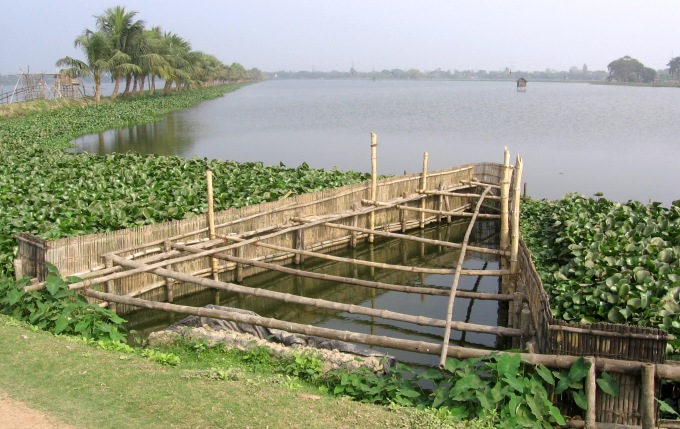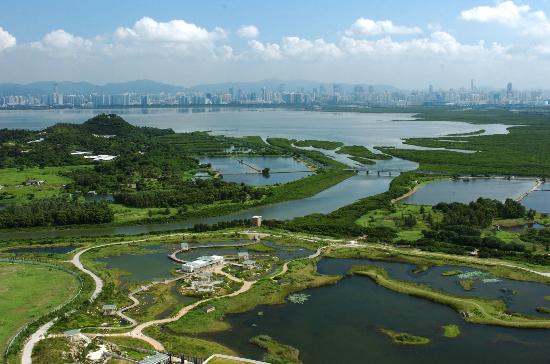According to the IPCC, “nearly 50% of coastal wetlands have been lost over the last 100 years, as a result of the combined effects of localised human pressures, sea level rise, warming and extreme climate events”1. Wetlands, however, are critical in climate change adaptation, and their protection and restoration is listed several times as a fundamental ecosystem- or nature-based solution in the fight for climate change, according to IPCC’s 2023 Climate Change Report2.
[1] IPCC, “Climate Change 2023 Synthesis Report.”
[2] IPCC.
What are wetlands?
Wetlands are areas in which the land is submerged in water, whether it be seasonally or permanently, and are differentiated by their hydric soils and hydrophytic vegetation. The plants within wetlands have special adaptations that allow them to flourish in the saturated environment, including floating leaves, waterlogged stems, and oxygen transport systems1. Due to frequent soil saturation, wetland plants have roots that are located in the upper zone, or within 30cm of the soil surface, a response to anaerobic conditions created by waterlogging2. The hydric soils are critical in managing the water balance within wetlands as they retain water and release it over time3.
There are various hydrological descriptors for wetlands, as they can be categorized by their flood duration, their flow of water, and by their salinity, influenced by groundwater flows. The flow of the water can be broken down into inflow (in which water comes in and does not leave), outflow (water flowing out), throughflow (water flowing in and out), and bidirectional flow (flux in water levels due to tides or levels of a nearby waterbody)4.
[1] Eyvaz and Albahnasawi, Wetlands – New Perspectives.
[2] Tiner, “Wetland Hydrology.”
[3] Eyvaz and Albahnasawi, Wetlands – New Perspectives.
[4] Tiner, “Wetland Hydrology.”
What are the types of wetlands?
While wetlands have different classification systems, one classification system breaks them down into three general categories: inland wetlands, coastal/marine wetlands, and human-made wetlands1.
Inland wetlands: rivers/streams, lakes, peatlands, marshes/swamps, forested wetlands, groundwater-dependent wetlands, vernal pools
Coastal/marine wetlands: estuaries, mangroves, seagrass beds, coral reefs, shellfish reefs, coastal lagoons, kelp forests, etc.
Human-made wetlands: reservoirs, agricultural wetlands (rice paddy, palm oil plantations, wet grasslands), wastewater treatment and constructed wetlands, saltpans, aquaculture ponds, etc.2
An overview of the various wetlands within Canada as well as a description of the key categories (bog, fen, swamp. marsh) can be found here.
[1] Gardner and Finlayson, “Global Wetland Outlook.”
What are the functions and benefits provided by wetlands?
Wetlands provide great value to society in through a range of crucial functions, including the following:
Flood control and erosion. This is provided by their ability to retain and release water, which is especially important during times of increased precipitation, where their sponge-like nature allows them to hold water and release it during times of low precipitation.
Maintenance of water quality. Wetlands purify water, working as a filter to remove sediments, excess nutrients, and contaminants.
Provision of wildlife habitat. Wetlands provide habitat for many animals, especially many species of birds, including shorebirds and migrating birds who stop to rest and feed there.
Sequestration of carbon. Wetlands act as a carbon sink, storing a large amount of carbon in their soils and vegetation1.
Role in biogeochemical cycles. Beyond their role in carbon cycles, wetlands also store nitrogen, phosphorus, and metals, which are retained through the wetland’s sedimentation processes. These chemicals may also be transferred to surrounding ecosystems through their hydrologic pathways2.
[1] Gardner and Finlayson.
[2] Faulkner, “Urbanization Impacts on the Structure and Function of Forested Wetlands.”
What are the current impacts on wetlands?
Historical rates of wetland loss were much higher than current rates as they were often drained and used for other purposes, without a full realization or consideration of the range of ecosystem services they provided. Today, wetland loss is especially prevalent in developing countries as population growth and increased agricultural production. While there is a greater understanding today of the value of wetlands, many anthropogenic factors still impact them, including1,2:
Sea level rise. A rise in sea levels will cause an increase in salinity due to saltwater intrusion in coastal wetlands, which will impact the vegetation that is able to grow and thrive there.
Urban development. An increase in impermeable surfaces and storm drainage, among many other changes including the quantity and quality of water that flows in and out of wetlands, as runoff carries pollutants into surrounding water bodies.
Deforestation. As deforestation increases erosion, there is an increase in the transfer of sediments to wetlands, ultimately damaging the ecosystems3.
Agricultural land use. Runoff from urban or agricultural areas brings with it pollutants or nutrients which then flow into adjacent areas. The excess of nutrients leads to eutrophication, potentially altering the plant community composition and/or producing algal blooms that degrade water quality and further affect plant and animal species that rely on the wetland habitat4.
Invasive species. They have the potential to outcompete native plant species, affect nutrient cycling, and alter the ecosystem and soil regime5.
[1] Keddy, “Causal Factors for Wetland Management and Restoration.”
[2] Gardner and Finlayson, “Global Wetland Outlook.”
[3] Gardner and Finlayson.
[4] Ward, “Wetlands Under Global Change.”
[5] Ward.
What implications does this knowledge have for design?
Given the many benefits provided by wetlands, it is important to take efforts towards wetland conservation. With climate change and its resulting impacts, a critical measure that can be taken to protect cities from sea level rise, flooding, and droughts is to integrate wetlands into the environment as a means of water storage and purification. The IPPC report for policymakers reiterates this stating that “ecosystem-based adaptation approaches such as urban greening, restoration of wetlands and upstream forest ecosystems have been effective in reducing flood risks and urban heat”1. While the knowledge of the importance of wetlands is becoming widespread, it is critical that cities and regions start and/or continue to include wetland preservation within their management plans.
[1] IPCC, “Climate Change 2023 Synthesis Report.”
Sources
Eyvaz, Murat, and Ahmed Albahnasawi, eds. Wetlands – New Perspectives. Vol. 7. Environmental Sciences. IntechOpen, 2023. https://doi.org/10.5772/intechopen.104315.
Faulkner, Stephen. “Urbanization Impacts on the Structure and Function of Forested Wetlands.” Urban Ecosystems 7, no. 2 (June 1, 2004): 89–106. https://doi.org/10.1023/B:UECO.0000036269.56249.66.
Gardner, Royal C., and C. Finlayson. “Global Wetland Outlook: State of the World’s Wetlands and Their Services to People,” October 5, 2018. https://papers.ssrn.com/abstract=3261606.
IPCC. “Climate Change 2023 Synthesis Report,” 2023. https://www.ipcc.ch/report/ar6/syr/. https://doi: 10.59327/IPCC/AR6-9789291691647.001
Keddy, Paul A. “Causal Factors for Wetland Management and Restoration: A Concise Guide.” Springer 8 (2023). https://doi.org/10.1007/978-3-031-21788-3.
Tiner, R.W. “Wetland Hydrology.” In Encyclopedia of Inland Waters, 778–89. Elsevier, 2009. https://doi.org/10.1016/B978-012370626-3.00018-1.
Ward, Eric J. “Wetlands Under Global Change.” In Encyclopedia of Inland Waters, 295–302. Elsevier, 2022. https://doi.org/10.1016/B978-0-12-819166-8.00142-0.
Additional resources
Urban Design Wetland Guide – The aim of this guide is to provide comprehensive and practical advice on the design and maintenance of constructed wetlands for the purpose of mitigating urban diffuse pollution. It is based on the London Borough of Enfield’s track record of delivering urban wetlands in a variety of settings.
Precedents
East Kolkata Wetlands
Location: Kolkata, India

“Water is life, and wetlands are the life support systems that ensure optimal functioning of the water cycle. Despite their tremendous value, wetlands are getting degraded globally due to natural and anthropogenic impacts. Considering the numerous challenges to the East Kolkata Wetlands, it was felt necessary to formulate an integrated Management Plan of the East Kolkata Wetlands for their conservation and sustainable development, ensuring livelihood opportunities for wetland communities.” -Dr. Saumen Kumar Mahapatra
This project is discussed by The Guardian and the Integrated Management Plan can be viewed here.
Hong Kong Wetland Park
Location: Hong Kong, China

“The mission of the Hong Kong Wetland Park is to foster public awareness, knowledge and understanding of the inherent values of wetlands throughout the East Asian region and beyond, and to marshal public support and action for wetland conservation. The Hong Kong Wetland Park will also be a world-class ecotourism facility to serve both local residents and overseas tourists.”
This project can be viewed on the Wetland Park website and here.
